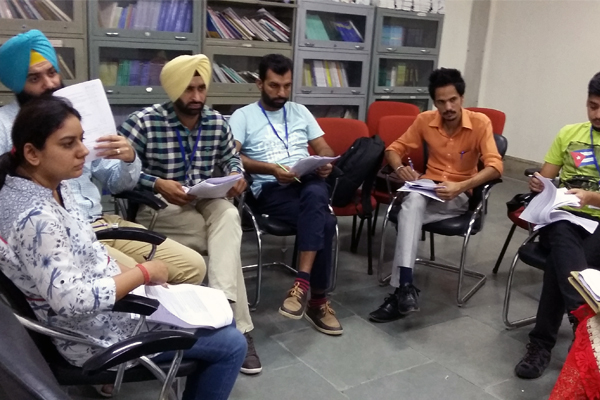

OF INDIA


The NMHS was undertaken as a large scale, multi-centred national study on the various dimensions and characteristics of mental health problems among individuals aged 18 years and above across 12 Indian states during 2014 - 16.
The selection of states was based on the availability of an interested and reliable partner organisation in that state, their willingness to undertake the study and the availability of screening and diagnostic data collection tools in the vernacular languages spoken in that state.
A Master Protocol outlining the study components, was developed to provide the overall guiding framework for conducting the study. A companion Operational Guidelines (OG) document (developed separately for the survey and for the mental health systems assessment) provided a step-by-step guide to the activities specified in the Master Protocol, ensuring that the survey was uniformly conducted across all the states.

The overall study design of the NMHS was multi-stage, stratified, random cluster sampling technique, with random selection based on Probability Proportion to Size at each stage (MSRS-PPS).
A multi stage sampling was adopted in each state and each selected state of India constituted the sampling frame. The districts and talukas within the states constituted the Primary and Secondary Sampling Units, respectively. Each named inhabited village as per the Census 2011 constituted a rural cluster, while a census enumeration block represented an urban cluster and individuals within the identified households formed the unit of analysis. The numbers of rural, urban metro and urban non-metro clusters were selected based on their respective proportions for the state. Within each cluster all eligible members (>=18 years) within the households selected using systematic random sampling method were interviewed. Thus, in total 34802 adults and about 1191 adolescents drawn from 12 states were interviewed.

The study instruments collected sociodemographic information including completed age, gender, education, occupation, income (house-hold and individual) and marital status. For assessment of mental morbidity, the Mini International Neuro-Psychiatric Inventory (MINI) adult version and the MINI-Kid version were used for adults and, older children and adolescents, respectively. In addition, additional questionnaires for tobacco use (Fagerstrom questionnaire) and to screen for Epilepsy, Intellectual Disability (ID) and Autism Spectrum Disorders (ASD) were also incorporated. Further, questionnaires on health care utilisation, assessment of disability (modified Sheehan’s scale) and socioeconomic impact of illness were used in the study. All data collection instruments were translated into the local languages of each of the surveyed states. Translated MINI instruments which were already available along with the other translated instruments were checked for social and cultural appropriateness, back -translated and then appropriate changes made for the final versions, which were then field-tested before use.

A team of 8 – 10 well trained field data collectors undertook data collection in each state based on micro planning steps after finalising field logistics. Training for the NMHS was conducted at 3 levels; first at NIMHANS for the core team, second for all PIs and Co-PIs from the selected states and third for state data collection teams. The data collection teams were trained for a period of 8 weeks. This involved two weeks of monitored data collection in the field. All the state teams were trained based on a uniform standardised training schema which enabled data collection in a standardized manner in all the states. Approvals were obtained from all local authorities and using the door knock method the field staff administered the questionnaires, using hand held tablet computers (Dell Venue 8 Pro 5000 series).












To maintain quality assurance, several steps were built into the protocol (i) monitoring of activities on daily, weekly and fortnightly intervals, (ii) certification of training for data collectors to ensure high levels of inter-rater reliability, (iii) fortnightly e-communications between teams, (iv) regular data checks and feedback and (v) 5% validation re-interviews by Field Data Collector supervisors and PIs of the respective states. Strict protocols were established for data transfer and management with access controlled mechanisms. Data received from all states was examined for errors and after checks, was used for analysis.
In addition to the household surveys, a total of 57 Focused Group Discussions (FGDs) and 69 Key Informant Interviews (KIIs) were undertaken in the states to provide qualitative information especially regarding certain areas, where it was felt that the survey method may not be adequately informative. These areas included patterns of substance abuse (both licit–alcohol & tobacco, and illicit substances), issues relating to mental illness and homelessness, the perceived treatment gap, stigma experienced around mental health and the barriers / challenges to mental health care delivery.
In the NMHS, the state and national estimates have been calculated based on the probability of selection of districts and talukas for design weight calculation. The individual non-response rate was used for the calculation of national pooled weights. The design weight was calculated to get a state level weight and the state level weights were pooled to get a national level weight.The International Classification of Disease, 10th revision, Diagnostic Criteria for Research (ICD 10 DCR). Current (Point) prevalence is reported for all diagnostic groups (ICD categories F10-19, F40-48), and both current and life-time prevalence (ever in the life of an individual in the past) is reported for select conditions under F20-29, F30-39 and panic disorders.


Dr. G. Gururaj
Dean & Senior Professor
Centre for Public Health,
Department of Epidemiology,
WHO CC for Injury Prevention and Safety Promotion,National Institute of Mental Health and Neuro Sciences,
Bengaluru, Karnataka 560029, India.
Phone (India) : +91 080 2699 5244
E-mail : epiguru@yahoo.com
Dr Mathew Varghese
Professor of Psychiatry
Head of Community Mental Health Unit National Institute of Mental Health & Neuro Sciences,
Bengaluru, Karnataka 560029, India.
E-mail : mat.vargh@yahoo.com